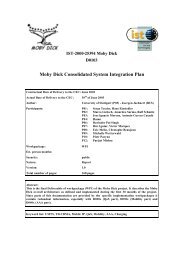COMNET III CACI
COMNET III CACI
COMNET III CACI
You also want an ePaper? Increase the reach of your titles
YUMPU automatically turns print PDFs into web optimized ePapers that Google loves.
Version 4.0 of the ATM Forum’s traffic management specification currently defines the<br />
following QoS parameters:<br />
1. Maximum Cell Transfer Delay (Max CTD): the cell transfer delay is defined to be<br />
the transmission delay of a cell between the source and the destination. Included<br />
in this measurement are the link delays along all the links on the end-to-end path,<br />
as well as all the ATM node processing delays. This parameter puts an upper<br />
bound on the end-to-end transfer delay for all cells.<br />
2. Mean Cell Transfer Delay (Mean CTD): this parameter indicates the average endto-end<br />
transfer delay of cells between the source and the destination.<br />
3. Cell Delay Variation (CDV): this measures the variability of the cell transfer<br />
delays, also known as jitter. The difference between the CDV and the CDVT is as<br />
follows: the former measures the actual jitter, whereas the latter is used in the<br />
context of the GCRA and therefore has an impact on whether the cell is<br />
conforming or not. The next appendix will clarify some details on the GCRA.<br />
4. Cell Loss Ratio (CLR): this parameter is defined by the ratio of lost cells to the<br />
sum of all the successfully transmitted cells (i.e. this excluded all dripped and<br />
errored cells).<br />
5. Cell Error Ratio (CER): this parameter is defined as the ratio of errored cells to<br />
the sum of the transmitted cells (i.e. it includes successfully and errored cells, but<br />
excludes all dropped cells).<br />
6. Severely Errored Cell Block Ratio (SECBR): this parameter measures the number<br />
of cell blocks in which cells have been lost, misinserted, or errored as a ratio of<br />
the total number of transmitted cells. A cell block is simply defined to be a<br />
sequence of user cells (typical block sizes are 28, 256, 512 or 1024 cells). If the<br />
number of errored, misinserted or lost cells within that block exceeds a certain<br />
threshold, then the cell block is counted as severely errored.<br />
7. Cell Misinsertion Rate (CMR): this parameter counts the number of misinserted<br />
cells over a specified period of time and expresses it as a ratio. A cell is typically<br />
‘misinserted’, if its header contains an error which is not detected and leads it<br />
subsequently to be transmitted along a different connection.<br />
Only the Max CTD, the Mean CTD, the CDV and the CLR are part of the negotiation<br />
process which takes place when the connection is established. The latter three parameters<br />
in the above list are simply calculated to indicate the QoS that the call has received from<br />
the network. The ATM Forum actually specifies 4 different classes for the QoS. Class 1<br />
is intended for circuit-emulation, class 2 for variable bit rate audio and video traffic, class<br />
3 for connection-oriented data transfer and class 4 for connectionless data transfer. These<br />
QoS classes map onto the service categories described above as shown in Table 22.<br />
73
















